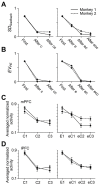Different types of uncertainty distinguished by monkey prefrontal neurons
- PMID: 35169710
- PMCID: PMC8842276
- DOI: 10.1093/texcom/tgac002
Different types of uncertainty distinguished by monkey prefrontal neurons
Abstract
To adapt one's behavior, in a timely manner, to an environment that changes in many different aspects, one must be sensitive to uncertainty about each aspect of the environment. Although the medial prefrontal cortex has been implicated in the representation and reduction of a variety of uncertainties, it is unknown whether different types of uncertainty are distinguished by distinct neuronal populations. To investigate how the prefrontal cortex distinguishes between different types of uncertainty, we recorded neuronal activities from the medial and lateral prefrontal cortices of monkeys performing a visual feedback-based action-learning task in which uncertainty of coming feedback and that of context change varied asynchronously. We found that the activities of two groups of prefrontal cells represented the two different types of uncertainty. These results suggest that different types of uncertainty are represented by distinct neural populations in the prefrontal cortex.
Keywords: frontal lobe; medial prefrontal cortex; nonhuman primate; prediction error; single-unit recording.
© The Author(s) 2022. Published by Oxford University Press.
Figures








Similar articles
-
Quantitative architecture distinguishes prefrontal cortical systems in the rhesus monkey.Cereb Cortex. 2001 Oct;11(10):975-88. doi: 10.1093/cercor/11.10.975. Cereb Cortex. 2001. PMID: 11549620
-
Multifaceted Contributions by Different Regions of the Orbitofrontal and Medial Prefrontal Cortex to Probabilistic Reversal Learning.J Neurosci. 2016 Feb 10;36(6):1996-2006. doi: 10.1523/JNEUROSCI.3366-15.2016. J Neurosci. 2016. PMID: 26865622 Free PMC article.
-
Representation of Behavioral Tactics and Tactics-Action Transformation in the Primate Medial Prefrontal Cortex.J Neurosci. 2016 Jun 1;36(22):5974-87. doi: 10.1523/JNEUROSCI.4572-15.2016. J Neurosci. 2016. PMID: 27251619 Free PMC article.
-
Auditory connections and functions of prefrontal cortex.Front Neurosci. 2014 Jul 23;8:199. doi: 10.3389/fnins.2014.00199. eCollection 2014. Front Neurosci. 2014. PMID: 25100931 Free PMC article. Review.
-
Involvement of basal ganglia and orbitofrontal cortex in goal-directed behavior.Prog Brain Res. 2000;126:193-215. doi: 10.1016/S0079-6123(00)26015-9. Prog Brain Res. 2000. PMID: 11105648 Review.
References
-
- Arnsten AF, Goldman-Rakic PS. Selective prefrontal cortical projections to the region of the locus coeruleus and raphe nuclei in the rhesus monkey. Brain Res. 1984:306:9–18. - PubMed
-
- Aron AR, Shohamy D, Clark J, Myers C, Gluck MA, Poldrack RA. Human midbrain sensitivity to cognitive feedback and uncertainty during classification learning. J Neurophysiol. 2004:92:1144–1152. - PubMed
-
- Aston-Jones G, Cohen JD. An integrative theory of locus coeruleus-norepinephrine function: adaptive gain and optimal performance. Annu Rev Neurosci. 2005:28:403–450. - PubMed
-
- Bach DR, Dolan RJ. Knowing how much you don't know: a neural organization of uncertainty estimates. Nat Rev Neurosci. 2012:13:572–586. - PubMed
LinkOut - more resources
Full Text Sources
